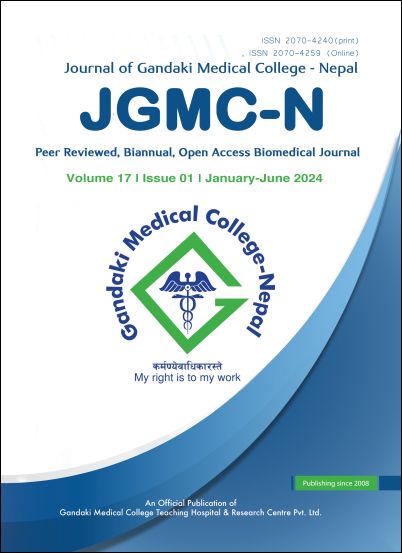Feasibility of Arantius duct maneuver for tunneling between middle and left hepatic veins and their isolation for liver resection: A cadaveric study
DOI:
https://doi.org/10.3126/jgmcn.v17i1.61755Keywords:
Arantius duct maneuver, left lateral hepatectomy, ligamentum venosumAbstract
Introduction: Arantius duct is the remnant of ductus venosus arantii which, during the fetal development connects umbilical portion of portal vein to the inferior-venacava. It runs from the left branch of portal vein and its fibers insert into either the left hepatic vein or pass between left and middle hepatic vein. Arantius duct when retracted, helps in isolation of left hepatic vein from middle hepatic vein, this maneuver is Arantius duct maneuver.
Methods: This cross-sectional observational study was carried out at College of Medical Sciences Teaching Hospital, Nepal. The study included 25 cadaveric livers. Meticulous dissection was done on the livers, data were collected in proforma and entered into IBM SPSS 16.0 and electronically analyzed.
Results: The mean length of the Arantius duct was 54.76±3.74 mm (48mm to 63mm). The mean thickness of the duct was 5.64±0.56 mm (4.8mm-7mm). The duct terminated at the common trunk of MHV and LHV in 16(64%) cases and terminated at LHV in nine (36%) of specimens. In the presence of common trunk, the Arantius duct maneuver for tunneling between the left and middle hepatic vein was successful in 14(87.5%) of the specimens in this study. The maneuver was 100% successful in isolating left hepatic vein when it had a separate origin.
Conclusions: Arantius duct maneuver is a safe approach to tunnel between the middle and the left hepatic veins and their isolation for liver resection. It allows better vascular control with less post-operative morbidity associated to increased blood loss and reduces the risks of hepatic congestion post-surgery due to possible vascular compromise.
Downloads
Downloads
Published
How to Cite
Issue
Section
License
Copyright (c) 2024 The Author(s)

This work is licensed under a Creative Commons Attribution-NonCommercial 4.0 International License.
This license allows reusers to distribute, remix, adapt, and build upon the material in any medium or format for noncommercial purposes only, and only so long as attribution is given to the creator.




